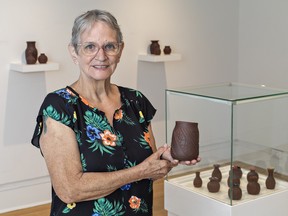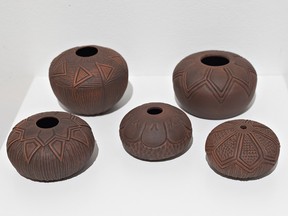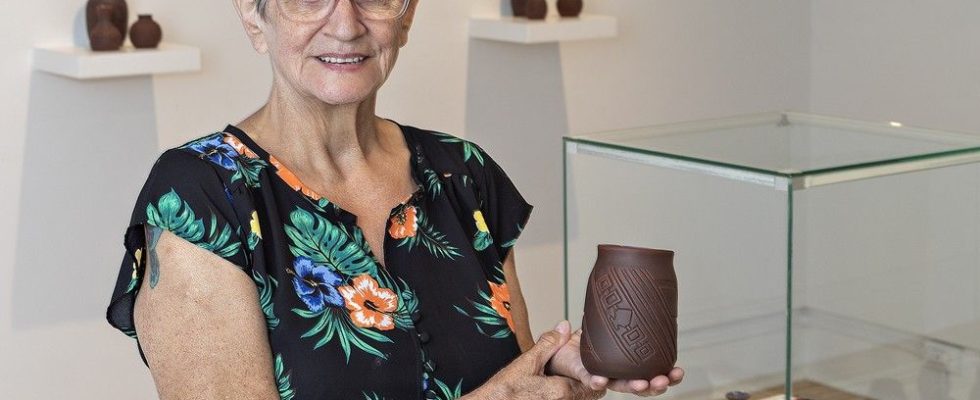
The revival of traditional Haudenosaunee pottery decades ago is the subject of an exhibition at Glenhyrst Art Gallery.
Advertisement 2
Santhony Pottery: Into the Fire features the works of Six Nations potter Cindy Henhawk.
Henhawk’s aunt, Elda “Bun” Smith, discovered pottery sherds near her Six Nations home in the 1950s and ’60s. The find made her wonder why the art of traditional Haudenosaunee pottery had seemingly disappeared.
“Smith was awarded an Ontario Arts Council grant that sent artist Tessa Kiddick to teach pottery techniques to a group of women on Six Nations in 1962,” explained Glenhyrst curator Matthew Ryan Smith. “Following Kiddick’s instruction, Smith continued to research historical Haudenosaunee pottery design. She is now credited for helping to revitalize Haudenosaunee pottery on Six Nations, which stands as one of the largest cultural renewal efforts in Canada.”
Advertisement 3
Henhawk, 61, said pottery has been in her life since the age of six, when Elda Smith went to California and showed Henhawk’s mother, Darlene Luane Smith, the process of making pottery.
Elda established a potters’ group that Darlene joined, and the women eventually established their own studios, Mohawk Pottery, and Iroquois Pottery.
“Since 2001 when my mother (Darlene) passed away, I thought who is going to carry it on?” Henhawk shared, noting that’s when she began making traditional pottery in earnest.
A variety of vases are included in the exhibition, each with intricate engraving that tells a story.
Wampum Belts is a vase that depicts seven wampums: the Hiawatha Belt, Two Row Wampum Belt, Hospitality Belt, Council Fire of Six Nations Belt, Condolence Belt, Friendship Belt, Tuscarora Take-in Belt, and a space left blank to honor lost, stolen, and missing wampum belts.
Advertisement 4

“The clay is a terra cotta colour, and the dark color is a wash to give it that dark, earthy colour,” Henhawk said, adding that most bud vases feature a colored glaze on the interior to match trees or water.
The Relationship Vase was inspired by works Henhawk has seen in the American southwest that symbolizes two becoming one.
“I wanted something just as meaningful for us,” she explained. “It explains everything that a relationship needs to survive.”
The vase depicts a hummingbird symbolizing honesty and trust, a hawk representing strength and courage, a flower for time and patience to grow, and a butterfly that represents a new beginning.
A variety of seed pots are also included in the exhibit.

“Our ancestors used the seed pot for storing and preserving seeds before planting season,” Henhawk said. “These containers are ideal because they provide a cool, dark, and dry place, which is optimum or the life of the seeds.”
Henhawk’s pottery has been shown in the Canadian Clay and Glass Gallery in Waterloo, the Royal Ontario Museum, the Museum of Archeology in London, England, the National Museum of the American Indian, and the Iroquois Indian Museum, both in the United States.
Santhony Pottery: Into the Fire continues at the Glenhyrst Art Gallery, 20 Ava Road in Brantford until September 17.

Comments
Postmedia is committed to maintaining a lively but civil forum for discussion and encourages all readers to share their views on our articles. Comments may take up to an hour for moderation before appearing on the site. We ask you to keep your comments relevant and respectful. We have enabled email notifications—you will now receive an email if you receive a reply to your comment, there is an update to a comment thread you follow or if a user you follow comments. Visit our Community Guidelines for more information and details on how to adjust your email settings.
Join the Conversation